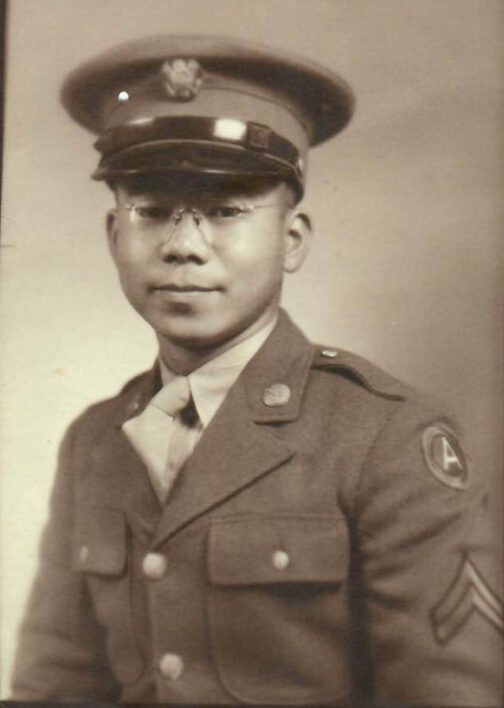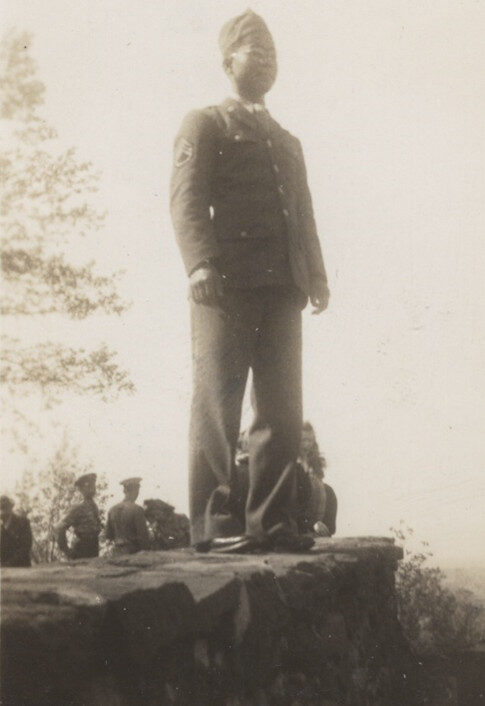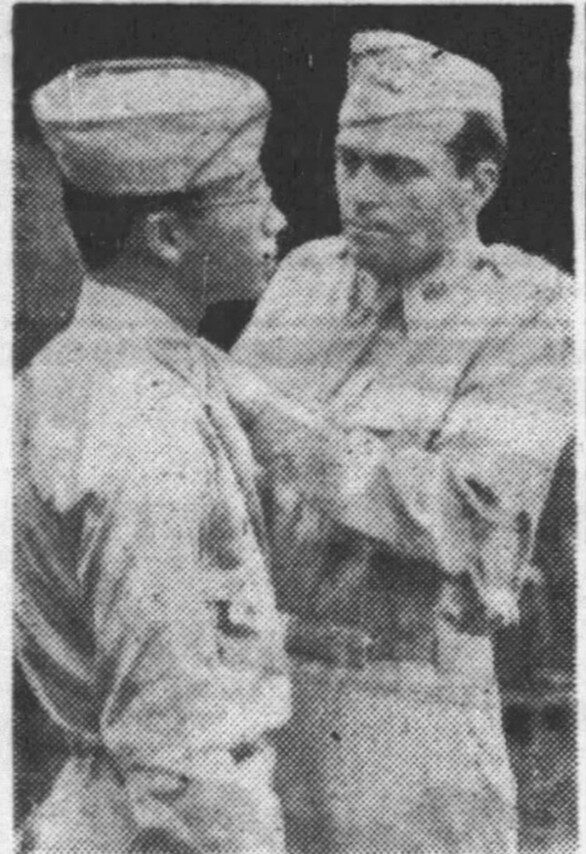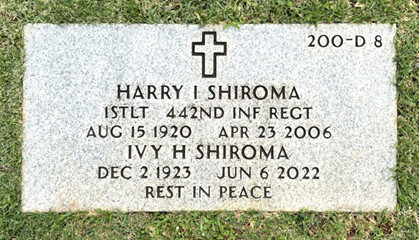Soldier Story: Harry Isamu Shiroma
Soldier Story

Harry Isamu Shiroma
1st Lieutenant
442nd Regimental Combat Team
2nd Battalion, G Company
Harry Isamu Shiroma was born on August 15, 1920, in Kaneohe, Oahu, Territory of Hawaii, to Kashin and Uto (Kohatsu) Shiroma. His siblings were: brothers Robert Shigeo, Max Seichi, Richard Saburo, and James Toshio; and sisters Dorothy Tsuruko and Jane Misao. His parents arrived in 1911 and 1913, respectively, from the village of Nishihara, Okinawa Prefecture, Japan.
In 1930, the family lived at Kemoo Farm in Wahiawa, where father Kashin was a pineapple farmer. On June 13, 1933, Kashin and Uto returned to Japan on the Asama Maru and took son Toshio with them. She and Toshio returned in 1935, but Kashin remained in Okinawa and was living at 195 Kohatsu in Nishihara.
In January 1939 while a senior at Leilehua High School in Wahiawa, Harry received an Honorable Mention in an essay contest sponsored by the Central YMCA. Later that year, he placed in the final three in an oratorical contest. While in high school, he worked as a waiter at the Kemoo Farm restaurant, as did his brother Shigeo.
Harry signed his draft registration card on February 15, 1942, Local Board No. 10, Wahiawa. His residence was 43 Circle Drive. His point of contact was his brother Shigeo Shiroma, whose mailing address was the same as Harry’s – c/o Kemoo Farm. Harry was employed by Mr. Whittaker of Hawaiian Construction at the U.S. Engineering Department (USED) at Wheeler Field. He was 5’4” tall and weighed 120 pounds.
Shiroma enlisted in the U.S. Army on March 23, 1943. His enlistment papers indicated he had completed two years of college and his civilian occupation was “Paymasters, payroll clerks, and timekeepers.” Harry was sent to the “tent city” known as Boomtown at Schofield Barracks with the other new soldiers of the 442nd RCT. He was present at the March 28 community farewell ceremony at Iolani Palace. The men sailed on April 4 on the S.S. Lurline for Oakland, California.
After arrival on the mainland, they were sent by train to Camp Shelby, Mississippi. Harry was assigned to 2nd Battalion, G Company. While there, he was promoted to Corporal in October 1943.
On April 22, 1944, the 442nd RCT left Camp Shelby after a year of basic, unit, and combat training and field maneuvers. They arrived at Camp Patrick Henry, Virginia, by train. On May 2, they sailed from nearby Hampton Roads in a convoy of over 100 ships to the Theater of War.
After entering the Mediterranean, the ship that was carrying 2nd Battalion (except its E Company) was diverted to Oran in North Africa to offload cargo, while the rest of the 442nd went to Italy, arriving at Naples on May 28. From Naples, they marched to the train station and were taken to Staging Area No. 4 at nearby Bagnoli. On June 6, the 442nd left on LSTs for Anzio. E Company was left behind in Bagnoli to await the arrival of the rest of 2nd Battalion from Oran. After they arrived on June 17, the 2nd Battalion remained at Bagnoli for about a week and then sailed on LSTs directly to the 442nd bivouac area 50 miles northwest of Rome at Civitavecchia.
The 442nd entered combat near Suvereto on June 26, 1944, in the Rome-Arno Campaign. They had continual success in pushing the Germans north along the west side of the Italian peninsula. On July 20 they had reached the area just south of the Arno River. There were unconfirmed rumors that the enemy was evacuating Pisa and pulling back north across the Arno. The 34th Division commander, Major General Charles W. Ryder, ordered the rumors to be confirmed or dismissed – and the 442nd was called upon to furnish the patrols to probe as far north of the Arno as possible. Company G furnished two 20-man patrols led by Lieutenant Arthur M. Boyd and Lieutenant Francis R. Bianco. They set out at 9:00 p.m. on July 20. In addition, L Company sent one 12-man patrol.

Shiroma was on one of the G Company patrols. They returned at midnight on July 21, having penetrated as far north as the Pisa airfield south of the city. They reported that the area south of the Arno River was still defended, although not heavily, by the Germans.
Right: Staff Sergeant Shiroma, 1944
After driving the enemy north to the Arno River, the 442nd was pulled from the lines and sent to Naples for shipment to France, where they joined in the Rhineland-Vosges Campaign. They arrived at Marseilles on September 29 after a 2-day voyage, and bivouacked at nearby Septèmes prior to traveling over 500 miles north by truck or rail boxcars to the Vosges Mountains.
Shiroma’s 2nd Battalion was transported north by truck. After three days of traveling in the rain and bivouacking in pastures, all elements of the 442nd, except 3rd Battalion, arrived at an assembly area at Charmois-devant-Bruyères on 12:30 p.m. on October 11. Beginning at 2:00 p.m. the following day, the Combat Team began moving into position for an attack the next morning.
The weather was cold, wet, snowy, and miserable, as the men fought in the heavily wooded forests still in their summer uniforms. They were subjected to living in wet foxholes, and incoming artillery raining down on them in “tree bursts.”
The objective was the important road and rail center of Bruyères, located in a small valley surrounded on three sides by hills, designated A, B, C, and D. For the next few days the fighting was fierce and bitter. The Germans had been ordered to defend Bruyères at all costs as it was so close to the border with their homeland.
On October 20, 1944, the sixth day of fighting to push the enemy from Bruyères and its surrounding area, Shiroma was involved in a firefight that earned him the Bronze Star Medal. The citation read in part:
While deploying his men against a German counter-attack, his platoon was fired upon by the enemy and two of his scouts were wounded. Without regard for his own safety, Sgt. Shiroma directed his platoon in securing a flanking position, repelling the foe.
During this action a German bullet pierced Shiroma’s helmet and took out his left eye. He was sent to the aid station and then on to the hospital.
In the December 11, 1944, edition of the Honolulu Star-Bulletin, in a letter Shiroma wrote home about the loss of his eye, he said that he felt very lucky – he was out of the fighting and sleeping with warm blankets, on clean sheets and a soft bed, and in a hospital with a roof over his head, he had a new glass eye that he could move with his eye muscles, and he survived the fighting with only this one wound.
My thoughts always drift back to the boys I left up there as I lie in bed and meditate….Those boys out there are fighting with wet clothes and eating cold K rations meal after meal…when I left them almost two weeks ago the weather was almost freezing.
Harry said that the two friends he had exposed himself to aid were killed almost at the same instant that he was wounded. He also lost the chance to receive a field promotion to 2nd Lieutenant after carefully rising in the ranks to Technical Sergeant.
The exact date of his return to the US and his discharge from the U.S. Army were not found in our research, although he was back in Hawaii by early October 1945. Records show that he reenlisted on November 14, 1945, and served until his final discharge on March 25, 1947.
For his military service, Technical Sergeant Harry Isamu Shiroma earned the: Bronze Star Medal with three oak leaf clusters, Purple Heart Medal, European-African-Middle Eastern Campaign Medal with two bronze star devices, World War II Victory Medal, Distinguished Unit Badge, and Combat Infantryman Badge. He was posthumously awarded the Congressional Gold Medal on October 5, 2010, along with the other veterans of the 442nd Regimental Combat Team. Conferred by the U.S. Congress, the award states: “The United States remains forever indebted to the bravery, valor, and dedication to country these men faced while fighting a 2-fronted battle of discrimination at home and fascism abroad. Their commitment and sacrifice demonstrates a highly uncommon and commendable sense of patriotism and honor.ˮ
The Bronze Star Medal was presented to Shiroma in Hawaii in early October 1945 by Lieutenant Charles R. Hill on behalf of Lieutenant General Robert C. Richardson, Commander of U.S. Armed Forces, Middle Pacific, as reported in the October 6 Honolulu Star-Bulletin.
Shiroma also received a Commendation from the 34th Infantry Division for service on a hazardous reconnaissance patrol that ventured three miles into enemy territory at Pisa, Italy, in 1944. The 34th Division Commendation stated in part:
The patrol had to cross several canals, travel over terrain that offered little cover or concealment, obtain information on enemy activities, discover the condition of roads and bridges into Pisa, also mines and booby-traps, and of the bridges across the Arno River. Every member displayed the highest soldierly qualities of skill, courage and determination.
In It was reported in the November 23, 1945, Honolulu Star-Bulletin that Shiroma received a “delayed” battlefield commission to 2nd Lieutenant for his “valor and exceptional leadership” in France, authorized by Lieutenant General Alexander M. Patch, Seventh Army commander. It was presented by Major Frank N. Seitz, commander of the 3190th Engineer Service Battalion. This was later changed to 1st Lieutenant by the U.S. Army and is reflected on his military tombstone.

In 1946, Shiroma received an Oak Leaf Cluster for his Bronze Star when the War Department awarded the Bronze Star to all soldiers who had earned the Combat Infantryman Badge for the intense fighting that had defeated the fascist Axis forces in World War II.
Left: Receiving his Lieutenant’s insignia, 2nd Lieutenant Shiroma and Major Seitz
After the war, Harry returned to the University of Hawaii and earned his Bachelor’s degree in Education in 1946. The following year he received a fifth-year professional certificate. After teaching at McKinley High School for one year, he left to study law at the University of Michigan.
Upon returning home from Michigan, Shiroma moved to Hawaii island where he taught school at Laupahoehoe, Paauhau, and Honokaa. On August 20, 1950, he married Ivy Haruko Oshiro (born December 2, 1923), the daughter of Toku and Moshi (Uehara) Oshiro of Honokaa. The wedding took place at Church of the Crossroads in Honolulu. Over the years, they raised a family of three sons. She was a nurse for the Department of Health.
On February 27, 1951, a special presentation ceremony was held for Lt. Shiroma in Honokaa in the presence of Headquarters and Headquarters Company, 3rd Battalion, 299th Infantry Regiment, Hawaii National Guard. Presented to him by Major Arthur H. Walton, on behalf of Lieutenant General Henry S. Aurand, commander of U.S. Army Pacific, were two more oak leaf clusters for his Bronze Star Medal (which he had received in person in October 1945). At this ceremony one oak leaf cluster was presented for:
…exemplary conduct in ground combat against the armed enemy while assigned as a Staff Sergeant with the 442nd Infantry Regiment on July 18, 1944, in the Mediterranean Theater of Operations [in Italy].
An additional Bronze Star oak leaf cluster was awarded for “meritorious conduct” on July 20 and 21, 1944, for his participation in the reconnaissance patrol at Pisa, Italy.
Harry transferred in 1955 from Paauhau School to Kawailoa School as its Principal. The next year he returned to Oahu, when he transferred to Kunia School as its Principal. After one year, he moved on to Hauula School as Principal, and in 1959 on again to Benjamin Parker School in Kaneohe, where he remained until 1975.
Harry Isamu Shiroma died on April 23, 2006, in Tripler Army Medical Center at the age of 85. He was a retired employee of the State Department of Education. Survivors included his wife Ivy and three sons. He was buried in the Hawaii State Veterans Cemetery in Kaneohe, Section 200-D, Plot 8. Ivy Shiroma died on June 6, 2022, and was buried next to her husband.

Researched and written by the Sons & Daughters of the 442nd RCT in 2025.